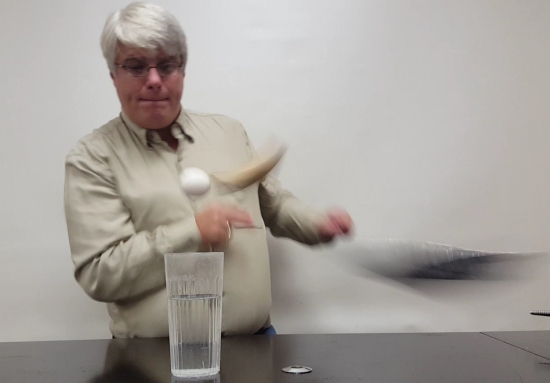
My publisher asked me to record an example experiment from the third book in my elementary science series, Science in the Scientific Revolution. This one is about inertia, and I cover the topic when I cover Sir Isaac Newton. It’s a potentially messy experiment, because in your desire to hit the pie pan hard, you might end up hitting the glass of water, knocking it over. Also, if you don’t hit the pie pan hard enough, you might end up just upsetting the system, resulting in a broken egg. However, if you can do the experiment correctly, it’s pretty impressive.
The concept of inertia was an important step forward in our understanding of motion. Up until the 14th century, most natural philosophers (that’s what scientists were called back then) believed what Aristotle taught: objects have a natural tendency to be at rest. Thus, unless something kept exerting a force on an object, an object in motion would eventually come to rest. This is consistent with our experiences. After all, if I kick a rock, it bounces down the sidewalk for a while, but it eventually comes to a halt. Even though Aristotle’s teaching is consistent with our experiences, it is nevertheless quite wrong.
In the 14th century, Jean Buridan (a natural philosopher whose work I discuss in Science in the Ancient World) questioned Aristotle’s teaching on the matter, indicating it wasn’t consistent with at least some observations. However, it took the work of Galileo Galilei to show that there was something seriously wrong with the idea. He ended up correcting Aristotle a bit. He said that at least when it came to motion on a level surface, objects will continue to move the way they have been moving, until they are disturbed.
Sir Isaac Newton ended up generalizing this principle, producing his First Law of Motion:
A body at rest or in motion will stay at rest or in motion until acted on by an outside force.
When you kick a rock, it starts bouncing down the sidewalk, and it would continue to do that forever if it weren’t for the outside force of friction. That force slows the rock down until it comes to rest. So the rock doesn’t come to a halt because its natural state is to be at rest. The rock has no natural state. It is simply responding to the forces acting on it. A kick gives it some motion in the direction of the kick, but friction opposes that motion, eventually forcing the rock to a halt.
One of the most spectacular confirmations of Newton’s First Law of Motion can be seen in the Voyager spacecraft. Despite the fact that neither of them has been been receiving any power from their engines for nearly 40 years now, they are still steadily moving away from the earth. Their engines gave them some velocity in that direction, and since there is almost no friction in space and they are far from the gravitational fields of the planets, they are not being acted on by a significant outside force. As a result, they have continued to move away from earth to the point where one of them is outside our solar system and in interstellar space.

Such a great experiment! We performed that one while studying Apologia’s Young Explorers Chemistry and Physics book.
You came up with that yourself? Out of household items? I can’t imagine that was easy.
Thinking about it, I guess that’s what you did with all the textbook experiments you came up with…
I didn’t come up with that one myself, Jake. I saw it a long time ago. In fact, I used to do that demonstration in my classes when I taught freshman physics at Ball State University more than 20 years ago!
Many of the experiments in my books are original to me, but some are ones I have seen before. In addition several of them are variations of ones I have seen at some point in my life. For example, this one is a variation of one that my high school physics teacher did with mimeograph paper (ask your parents what that is).
This is a very useful post, Dr Jay. The tips on how to avoid mess ups are great.
I have such happy memories of that experiment. Before I did it with dd, I watched a couple of videos. This one is great fun, especially for the wise-cracking (“Science isn’t for sissies!”) and the bit at the end where Steve Spangler decides to use 5 eggs!!
https://www.youtube.com/watch?v=6gzCeXDhUAA
There are lots of science teachers online. However, I do find that *your* explanations of the *principles* behind the experiments are much more thorough than what is available elsewhere.
PS What’s happening on the book writing front, Dr Jay? Are you publishing another book this soon?
That’s a great link, Anthea. I hadn’t seen it done with multiple eggs!
Thanks for your kind words. They mean a lot.
In answer to your question, my publisher should be coming out with the final book in my elementary series in the spring of 2017. It’s called Science in the Industrial Age, and it covers the science that was discovered in the 1800s.
Thanks for sharing this Dr. Wile. You (and your books) make physics so much fun! I’ve always enjoyed the experiments in your textbooks.
According to Christopher M. Graney of Jefferson Community & Technical College, Mass, speed, direction: John Buridan’s 14th-century concept of momentum, The Physics Teacher 51(7):411–414, October 2013:
“In the 14th century the French thinker John Buridan developed a theory of motion that bears a strong resemblance to Newtonian momentum. Buridan’s ideas include a quantity of motion which is determined by an object’s mass, speed, and direction; in the absence of resistive effects, this quantity remains with the object. Buridan’s work is an interesting story in the history of physics. Buridan’s insights have value for introducing concepts of inertia and momentum to physics students.”